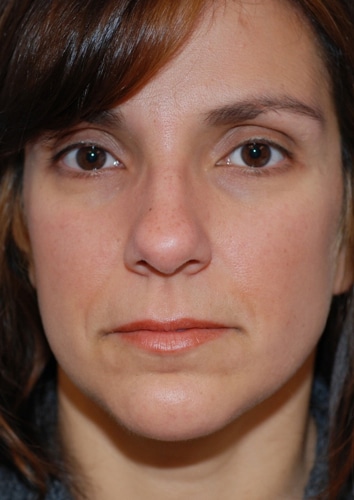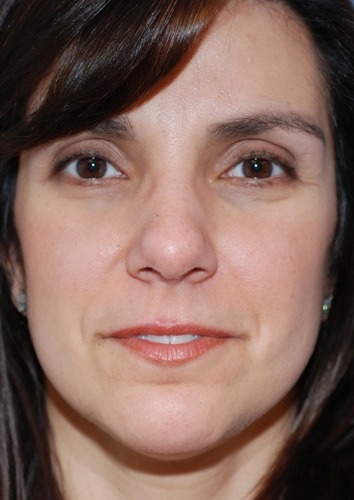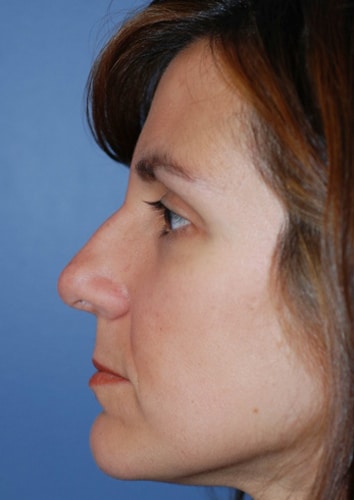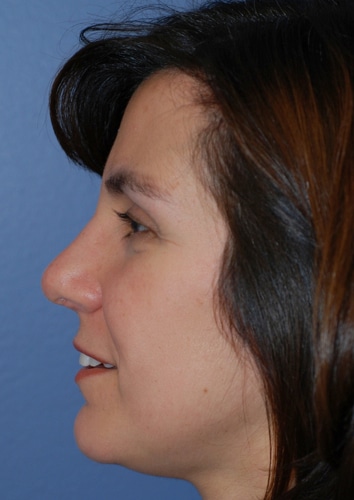As one of the few double-board certified surgeons in both Plastic Surgery (focused on changing the appearance of the nose) and Otolaryngology (functional nasal surgery, Ear, Nose and Throat Surgery) Dr. Samuel Lin continues to be able to positively change the shape of one’s nose while improving and preserving the nasal function and breathing for patients near Boston. By specializing in nose reshaping, Dr. Lin can help patients that suffer from a deviated septum, have trouble breathing through their nose, and individuals that are interested in changing the appearance of their nose even from a previous Boston nose job.

The nose is perhaps the most noticeable part of the face, due to its central location. Minor deformities and irregularities are very difficult to hide or camouflage and are more eye-catching than any other area of the face. Nasal proportions should be in harmony with each other and with the rest of the face and body features. A long thin nose that looks balanced in a tall, thin person with a long face will look out of place in a short stocky person with a wide face.
Read Dr. Lin’s Answers To Patients’ Rhinoplasty Questions
Aesthetic Rhinoplasty: Changing The Appearance Of The Nose
Rhinoplasty (commonly referred to as a nose job or nose surgery) is the art of enhancing the shape of the nose and may involve improvement of the breathing. Rhinoplasty can be done by open or closed approach according to the degree of nasal deformity and the corrections needed to be done. In the closed rhinoplasty all the incisions needed to reshape the nose are made from inside the nose, while in open rhinoplasty there is a small incision done at the base of the nose between the 2 nostrils at the columella (the portion of your nose between your nostrils).
This columellar incision is usually unnoticeable due to its hidden location and usually heals exceptionally well. Aesthetic, or cosmetic rhinoplasty, involves changing the outward appearance of the nose. This may involve reshaping the bridge of the nose or tip of the nose, along with other areas. It is important to be able to preserve the function of the nose and being able to breathe through the nose after these procedures are performed.
Functional Rhinoplasty: Improvement Of Breathing
Functional rhinoplasty involves improving breathing after one has had a prior nose surgery or nasal trauma/broken nose. This procedure may be done to improve the nasal airway as well as the outward appearance of the nose. Dr. Samuel Lin’s specialty is functional and cosmetic rhinoplasty, as he is Board Certified in Plastic Surgery and Otolaryngology-Head and Neck Surgery (Ear, Nose, and Throat Surgery). Insurance may cover portions of nose surgery relating to breathing issues.
Patients that Dr. Lin sees usually fall into several groups of people. Patients who:
- Have already had a nose job who would like to make further changes to the visible part of their nose and/or have breathing difficulty through their nose. Patients who are in this category may be candidates for a Revision or Secondary Rhinoplasty.
- Have not had a nose surgery previously who would like to improve the outside appearance of their nose and/or would like to breathe better through their nose.
Functional Airway Surgery, or surgery to improve breathing, which is sometimes performed at the same time as Nose shaping, may involve various placement of a patient’s cartilage to help provide support to the nostril or internal mechanics of the nose. These cartilage support grafts may be placed at the nostril area or at the valve area of the inside of the nose as depicted below.
Rhinoplasty Before & After
Rhinoplasty Patient Testimonials
Rhinoplasty FAQS
Nose surgery is one of those procedures that patients have typically thought about for years, even decades. Cosmetic findings with the nose are always right there in front of your face in the mirror every morning. The first thoughts of making changes usually surface in a person’s teenage years and can be a lasting point of dissatisfaction with a person’s self-image.
Reality? Pretty much anyone who doesn’t like his or her nose is a good candidate for nose surgery. The one qualification is age: the patient’s nose has to be fully-grown. This occurs commonly at 15 to 16 for a girl, at 17 for a boy. There are many reasons people seek to change their nose. They usually fall into three categories:
Appearance
This is the most common reason for nose surgery, to change the look of the patient’s nose. The surgery can really impact a person’s self-confidence. These are some of the most common reasons for cosmetic nose surgery:
- The tip droops or plunges
- The tip is enlarged or bulbous
- There is a bump or depression on the bridge
- The nostrils are excessively flared
- The nose is too wide or too large proportionally
- The nose is crooked or off-center
Injury
Sport injuries, car accidents, and other trauma can leave the nose misshapen.
Breathing
Some people are born with constricted nasal passages. Rhinoplasty can open the nasal passages and improve function.
Yes, frequently patients do end up combining both a functional and an aesthetic rhinoplasty.
Rhinoplasty is a very centralized surgery, so it is possible to combine it with another procedure into a single surgical session. Some patients opt to change the shape of their chin by having Dr. Lin place chin implants. The combination of a more defined chin complements the changes made with your nose. Eyelid surgery would be another option to rejuvenate your eyes while making the changes you’ve always sought for your nose. Your nose surgery will exacerbate the swelling around your upper cheeks and eyes to some degree, but it won’t affect an eyelid procedure.
If you’d like to consider combining procedures, this is something to discuss with Dr. Lin during your consultation.
In cases primarily of improvement of function, insurance plans do cover procedures usually. Any cosmetic or nose shaping regarding outside appearance is not covered by insurance.
In the majority of cases, functional nasal procedures inside the nose do not change the shape of the nose.
Dr. Lin will address what you need to do before coming to the surgery center. This is not a “set” procedure, meaning there are many variables based on the patient’s individual needs. The two of you will decide whether local anesthesia with sedation or general anesthesia is the way to go. Currently, COVID testing is required 48 hours before surgery.
As discussed in the procedure section, this surgery may be performed using the open method through an incision at the columella between your nostrils or closed with all the incisions made inside the nose. If you are augmenting your nose size, Dr. Lin will likely take cartilage or bone from your rib in rare cases, or he may use implant material. This can create another, albeit minor, recovery site.
After your surgery, you’ll be in bed with your head raised to reduce bleeding and swelling. There will likely be internal dressings that will stay in your nose for one to seven days. Dr. Lin will also tape a splint to your nose for protection and support. Slight bleeding and drainage of mucus and old blood are common for a few days after the surgery.
You’ll need to avoid any strenuous activity for a month, so as not to raise the blood pressure to your face. You can’t blow your nose, and it is best to take baths rather than showers while you still have bandages on your nose. Wear only clothes that button to avoid pulling clothes over your head and hitting your nose.
After your surgery, your nose will be splinted frequently. This protects and supports the new structure. You’ll need to keep your head elevated as much as possible during your first few days of recovery, including while sleeping. You’ll have swelling and both eyes will likely blacken. The splint will come off in one week or so, but your nose will remain swollen for 2 months and up to 1 year for swelling to go down. After that, you will have some residual swelling that can persist for weeks, especially late in the day and at night. Strenuous exercise will have to be put off for several weeks. Obviously, any sport that can impact your nose will need to be avoided for a few months.
On average, one week is enough time to recover. There are patients who take more or take less time following a nose job however.
The first steps in having rhinoplasty involve understanding a few things: is the reason for having a procedure functional in nature or cosmetic/interest in changing the appearance of the nose? If one is interested in changing the shape of the nose, what specific areas are of interest? Having a rhinoplasty requires significant thought and consideration before the procedure.
Rhinoplasty is the most common facial plastic surgery. It is also one of the original plastic surgeries, the first documented rhinoplasty being performed in 1887. This is surgery, so it entails all of the risks inherent with that: excessive bleeding, reaction to anesthesia, infection, and the like. These are all very rare with nose surgery.
Specific to this procedure, there are risks of permanent numbness in and around your nose. Breathing difficulties can develop. The main risk is the patient won’t be satisfied with the changes in his or her nose.
Again, that’s where the experience and training of Dr. Lin benefits patients. Dr. Lin is double board certified in both plastic surgery and in otolaryngology — head and neck surgery. His extensive experience and skill set is fully employed to make sure as best possible that you are pleased with your new nose.
If Dr. Lin uses the closed method, all incisions are made within the nose, so there isn’t any scarring. However, even with the open method, Dr. Lin makes a single incision across the columella, the area at the bottom of your nose separating your nostrils. This is a small incision and it heals quite well. It becomes virtually invisible, plus this is an area that isn’t seen by anyone.
For rhinoplasty surgery, it is advised to usually wait at least a week to three weeks after surgery to fly.
You’ll want to wear makeup to cover some of the bruising after this procedure, which often blackens both of the patient’s eyes. There aren’t any limitations on wearing makeup, as there aren’t any incisions involved other than the small one on the bottom of your nose. The key is not to push on your nose, so as long as you place any makeup carefully it’s not a problem. One thing to consider, however, is that you’ll also have to use care taking it off, but that shouldn’t be a problem.
It’s not makeup, but wearing glasses is a problem after nose surgery. Once Dr. Lin removes your splint, you’ll need to not wear any type of glasses for about 4 weeks. This is to avoid creating a permanent dent in the top of your nose while the bones are healing. If they are absolutely necessary and you cannot switch to contact lenses, you can hold your glasses in place (and off the bridge of your nose) by taping the bridge of your glasses to your forehead using skin-colored tape.
Dr. Lin’s Research On Rhinoplasty
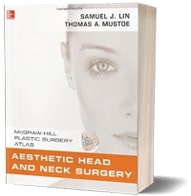
Aesthetic Head and Neck Surgery (McGraw-Hill
Plastic Surgery Atlas)
1st Edition
Schedule Your Consultation Today!
Interested in learning more about Rhinoplasty? Call 617.632.7827 to book your consultation with Boston plastic surgeon Dr. Samuel Lin today!

